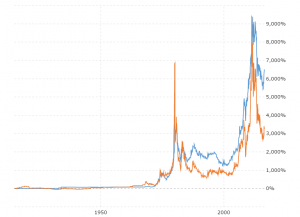Antique Coins – the Thaler
Every wondered where the word ‘dollar’ comes from? The answer opens a door into the history of coins, and it reminds us that the past has been around a long time. Antique coins are great collectors’ items, and it is easy to become a specialist in one particular era, or type of coin.
So back to our question – the word dollar comes from a coin that was around for 400 years – the Thaler. That name itself is an abbreviation for Joachimsthaler, which in turn is named after the town of of Joachimsthal, today in the Czech Republic, but once in the Kingdom of Bohemia. That kingdom was a state in the Holy Roman Empire, which was the complex of countries across most of Europe that developed out of the ruins of the classical Roman Empire. It persisted until 1806, becoming the Habsburg Kingdom after that.
A ‘thal’ is a valley, and a thaler is something from a valley, and around the ‘valley of Saint Joachim’ were silver mines. From that silver, in 1518, the first Thalers were minted. On the obverse of the earliest Thalers is an image of St. Joachim, father of the Virgin Mary, with the shield of Bavaria and the minting date. On the reverse is a lion, surrounded by the name of the king – in the earliest coins, until 1526, that was King Ludovicus. He was king not only of Bohemia, but also of the kingdoms of Hungary and Croatia.
What is remarkable about these coins, now 500 years old, is how similar they are in layout to a modern coin. There in a ‘head’ on one side, and an image on the ‘tails’ side (well, yes, a lion does indeed have a tail, although it is more likely called a tail because that is what we find at the opposite end of an animal from its head). There too is the date of minting, and an indication of who issued it. The overall layout of coins is remarkably stable over the centuries and even millennia.
Coins before the thaler contained very little precious metal, largely because the reserves had been depleted buying goods like silk and spices from overseas. Then new silver mines were discovered, and Italy was the first country, in 1472, to create new coins with a high precious metal content. The silver mines around Joachimsthal were part of that development, and so the Thaler was born. It was originally a local version of an earlier coin, the Guldengroschen, or large guilder, because it was in silver, but of equal value to Goldgulden, or gold guilder, and therefore of larger size. It weighed at first one ounce, or 27.2 grams, but it soon became standardized to contain 400.99 grains of silver, equivalent to 25.964 grams. The Thaler rapidly became the standard coin for trade across the Holy Roman Empire.
Over the following years changes in weight and purity became common, as governments struggled to standardize currency, and numerous different ‘thalers’ were born, including Lösers, or ‘multiple thalers’, which were larger coins weighing as much as 16 thalers – a one-pound coin. Today the rarity of Thalers varies with their era, and of course their quality too, but a collector could build a rich collection just with the many variations created over the 400-year life of this predecessor of today’s dollars.
















